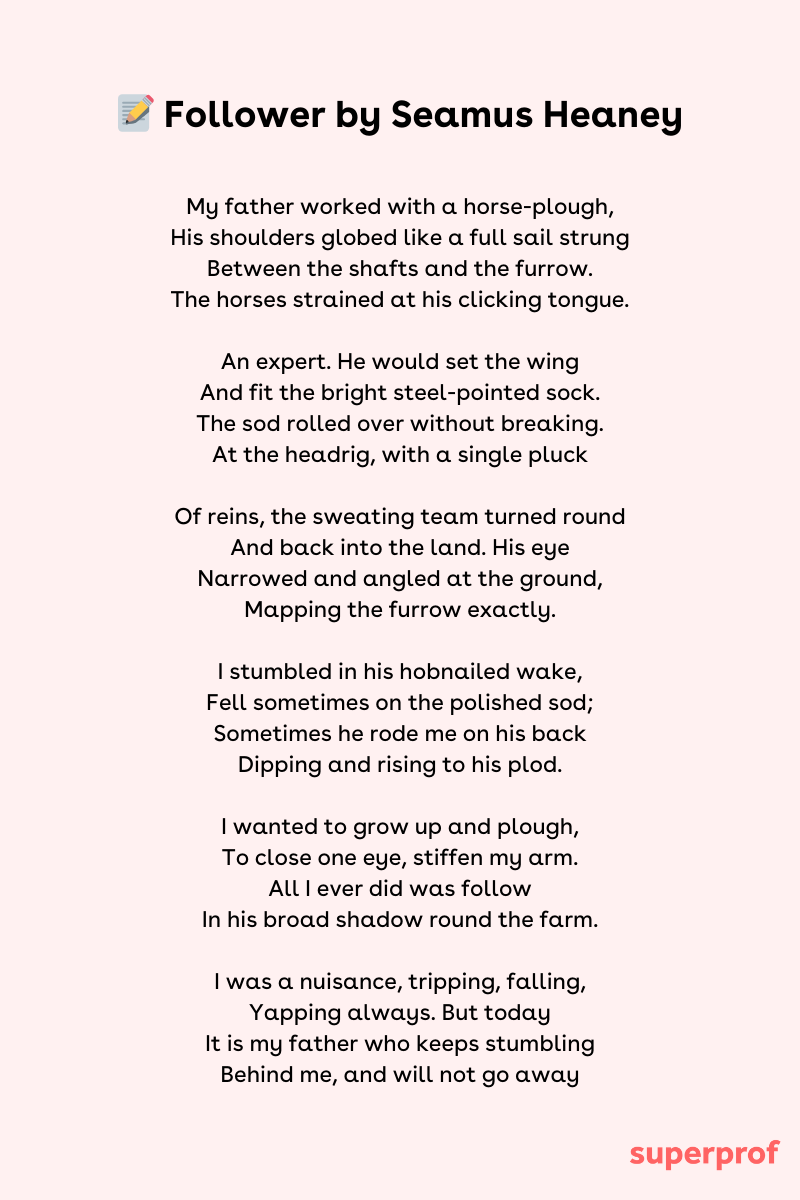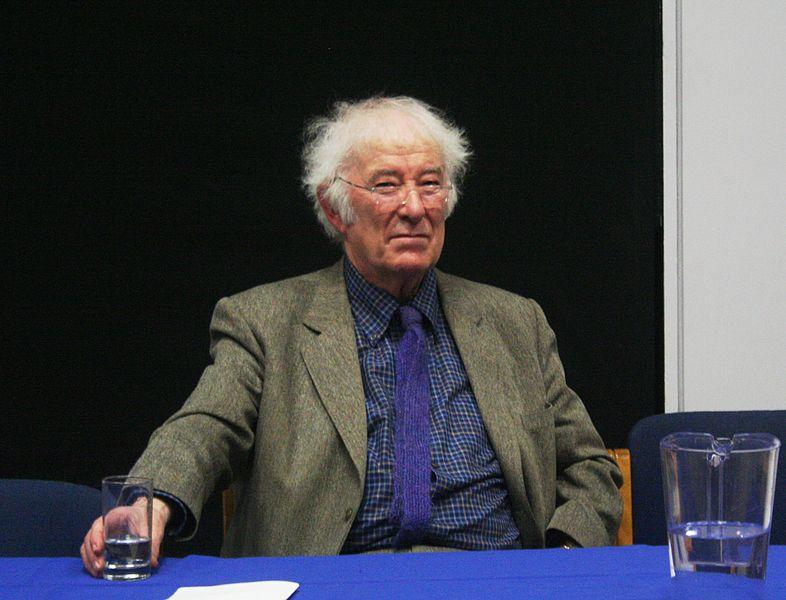Chapters
A fascinating medium of art, Poetry has the remarkable ability to connect with readers of all ages on a deep and emotional level, and Seamus Heaney's "Follower" is yet another shining example of this.
Exploring the deep bond between father and son, this poem is designed to take you on a thought-provoking journey through their complex relationship.
In the following article, we’ll take a closer look into the poem's structure, language, and its themes, while also examining how the author's own background and life experiences ended up playing an integral role in influencing his work.
So why not join us on a journey into the heart of what makes Seamus Heaney's “follower” a poetic masterpiece?


Who Was Seamus Heaney?
Born into a family of farmers in County Derry, Ireland, in 1939, Seamus Heaney quickly rose to fame as a brilliant poet and talented writer. All in all, his upbringing would play a huge part in shaping his poetic vision and many of the themes he would explore in his poems throughout his long career would be inspired by this meaningful period in his life.
Growing up in the rural country, Heaney found himself surrounded by beautiful nature, and was expected to work hard to earn his keep, forming strong bonds with his family as a result. It was these experiences that drove him to create one of his greatest poems “follower”, which was set against the backdrop of the farming community.

Before his death in 2013, Heaney received numerous awards and recognitions for his poetry work, including the Nobel Prize in Literature, leading him to be remembered as one of the greatest poets of the modern day.
How is “Follower” Structured?
Follower is six stanza type of poem, with each individual stanza consisting of four lines which are called quatrains. Fascinatingly, this consistent use of quatrains is supposed to mirror the steady rhythm of the protagonist's fathers work on the farm.
Additionally, Heaney also uses a consistent rhyme scheme throughout his poem too, which adds to its musical quality and helps to tie the stanzas together. For example, in each quatrain, the first and third lines will rhyme with each other, as do the second and fourth lines.
Sometimes these rhymes are full rhymes, where the words sound identical, like "wing" and "breaking." However, at other times, Heaney uses slant rhymes instead, where the words have similar but not exactly the same sounds, such as "sock" and "pluck."
This mix of full and slant rhymes is used in order to create a subtle rhythm that draws the reader in without becoming too predictable and boring.
Lastly, keen poetry enthusiasts may have also noticed that each line in “Follower” is roughly around the same length. By writing the poem deliberately like this, Heaney hoped to convey an image of the son following in his father's slow and measured footsteps.
My father worked with a horse-plough,
His shoulders globed like a full sail strung
Between the shafts and the furrow.
The horses strained at his clicking tongue.
How Does Heaney Use Language and Imagery to Evoke Emotion?
Arguably one of the best aspects of the “Follower” is the way in which Heaney uses language and imagery to evoke emotion in the reader or listener.
From beginning to end, he manages to paint a vivid picture with his words alone in bid to help the reader visualise the scenes and emotions felt by the narrator.
For example, take this passage where he describes his father hard at work - "His shoulders globed like a full sail strung - Between the shafts and the furrow." By comparing the father to a ship, readers can almost feel the man's strength, physical prowess, and determination to complete the task at hand.
Additionally, Heaney also makes use of a clever technique called alliteration in this passage too, repeating the "s" sound in both "shoulders," "sail," and "strung." Again, he does this in an effort to echo the steady repeated movement of the father ploughing the field.
What Central Themes Does "Follower" Explore?
As mentioned before, “follower” follows the relationship between a father and his son as they work together to plough the fields on their farm - hence the name of the poem. But what themes are present throughout it?
From the very start of the poem, it becomes incredibly clear that the son sees his father as a powerful and almost heroic figure. Wanting to follow in his father's footsteps, he tries to emulate him in any way he can.
However, despite his best efforts, the son sadly struggles to match up to his father's skill and confidence - at least initially. For many, this theme of the son's struggle to live up to his father is a feeling a lot of people can relate to, especially during their childhood years.
Additionally, another important theme in “follower” revolves around the pressure to continue age-old family traditions. To the father, his work as a farmer isn’t merely a job, but a way of life.
Keenly aware of this fact, the son feels a strong pull to take on the role of the farmer one day, even as he grapples with his own sense of self and desire to forge his own path in the world.
Taking place in Ireland, the poem also introduces us to many of the traditions associated with farming in the country, using interesting and descriptive words and phrases such as "polished sod" and the "furrow" to make the reader feel as if they are actually there themselves.
Finally, the poem also touches on the theme of the passage of time and the inevitability of change. For instance, in the final stanza, the role between father and son is eventually reversed, with the father becoming the one who now stumbles behind in his son's footsteps.
Conclusion
In conclusion, Seamus Heaney’s “Follower” is an expertly written poem that takes place in the countryside of Ireland and follows the relationship between father and son. By combining a mix of vivid imagery, memorable words and phrases, and exploring many relatable themes - the poem offers a poignant and moving reflection on family, tradition, and more.
In addition to this, Heaney's own experiences growing up on a farm in County Derry heavily influenced his writing, which adds an extra layer of authenticity to one of his greatest works.
Review Questions
Test your knowledge of the poem and practice your analysis skills with these practice questions:
Describe the structure of "Follower" and how it mirrors the poem's themes.
Required field
Responses could address any of the following points to discuss the link between the structure of the poem and the poem's themes:
- "Follower" consists of six stanzas with four lines each.
- The structured quatrains reflect the steady rhythm of farm work, emphasizing tradition.
- A consistent rhyme scheme adds musicality and unity to the poem.
- Varied rhymes create a subtle rhythm, mirroring the complexities of the father-son relationship.
- Deliberate line lengths symbolize the son following his father's footsteps, echoing themes of emulation and identity struggle.
What central themes does "Follower" explore, and how are they reflected in the poem?
Required field
Responses could discuss any of the following themes:
- Tradition and Heritage: Reflects on the deep-rooted tradition of farming and familial expectations, symbolizing the continuity of family heritage.
- Identity and Autonomy: Explores the complexities of identity and the struggle for autonomy within the context of the father-son relationship.
- Passage of Time: Highlights the inevitable shift in roles and responsibilities as time progresses, symbolizing the cyclical nature of life.
- Youth and Aging: Offers a poignant reflection on the fleeting nature of youth and the bittersweet reality of aging, emphasizing the passage of time and the nostalgia for lost innocence.












